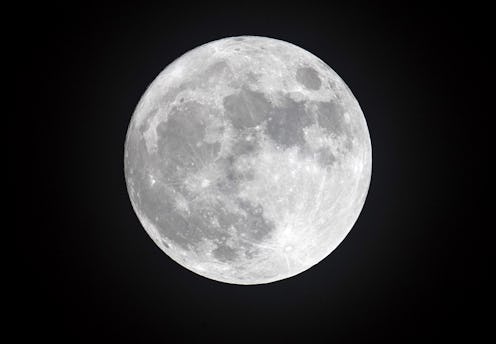
Hey guys, what are your plans this Friday? Big night out? Cozy night in? Dancing under the Snow Moon? If you're wondering, "What does the Snow Moon mean?" well... yeah, that's legitimate. I kind of came out of nowhere with that one. But I promise, once you learn the history of February's full moon and its name, you'll look at the sky differently on Feb. 10 (which, in case you missed it, is when the February full moon is for 2017. Just FYI).
Generally speaking, each month brings us one new moon and one full moon. There are exceptions, in which case the second new or full moon of the month is called either a Black Moon or a Blue Moon — but usually, we experience one of each. Each full moon is traditionally accompanied by a name that indicates something about its nature, a practice begun by the Algonquin tribes of what is now the East Coast. It makes sense, living in a world where celestial events marked the passage of time, to distinguish between monthly occurrences in a way that reminds you that while life is forever marching forward, nature operates in a cycle. In incredibly stressful, acrimonious times (like, you know, right now), when a single day can feel like an eternity, there's comfort to be found in thinking about absolutes like the lunar cycle.
February, the shortest and arguably dreariest month of the year, is called the Snow Moon, because yep, you guessed it, February is traditionally the snowiest month of the year. It's also sometimes referred to as the Hunger Moon, since food supplies often began to dwindle this late into the winter, and the heavy snows made hunting difficult.
Unsurprisingly, the Algonquins were hardly the only ones to name the monthly moons. In Chinese culture, for example, February brought the Budding Moon; meanwhile, Celtic people called it the Moon of Ice. In the Southern Hemisphere, where the seasons are switched, February is mid-summer; as such, the host of moon names used down there — Grain Moon, Sturgeon Moon, Red Moon, Wyrt Moon, Corn Moon, Dog Moon, Barley Moon — reference abundance instead.
This month, the Snow Moon will be sharing the sky with several other celestial events. On Feb. 10, 2017, the night of the full moon, there will also be a penumbral lunar eclipse, which occurs when the Earth, Moon and Sun are imperfectly aligned, causing the Earth to cast its shadow across the Moon — and, several hours later, an appearance of the "New Year Comet," officially named Comet 45P.
What! A! Night!